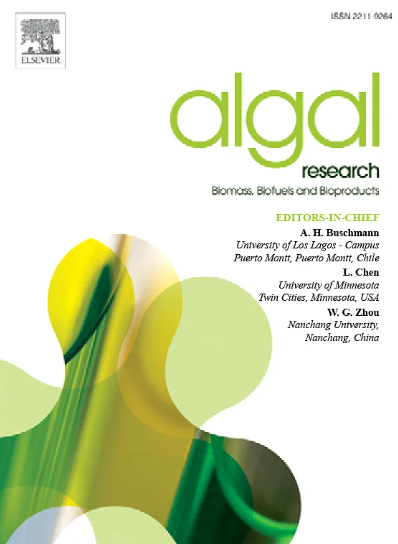Techno-economic analysis of microalgae cultivation strategies: batch and semi-continuous approaches
IF 4.6
2区 生物学
Q1 BIOTECHNOLOGY & APPLIED MICROBIOLOGY
Algal Research-Biomass Biofuels and Bioproducts
Pub Date : 2025-05-24
DOI:10.1016/j.algal.2025.104109
引用次数: 0
Abstract
Algal biomass is a promising sustainable feedstock for low-carbon fuels, chemicals, and proteins, but large-scale deployment remains economically challenging due to high cultivation costs. This study evaluates the economic viability of algal biomass production using batch and semi-continuous cultivation in open raceway ponds. A modular engineering process model was developed to quantify mass and energy flows across key processes, including seed production, biomass cultivation, and dewatering. Two seed train configurations were evaluated: high-density systems using photobioreactors and low-density systems relying on covered and lined ponds. This process model informed a techno-economic analysis to determine the minimum biomass selling price (MBSP) across four cultivation and seed train scenarios. Results indicate that semi-continuous cultivation achieves a lower MBSP ($1130–$1200 per metric tonne) than batch cultivation ($1380–$2040 per metric tonne), primarily due to reduced seed train costs. Seed production costs ranged from $40 to $350 per metric tonne in low-density configurations and $105 to $940 per metric tonne in high-density configurations, making batch systems with high-density seed trains economically unviable. Economic viability in semi-continuous cultivation was found to be sensitive to culture stability, with cost-parity reached if mean-time-to-failure decreases to 26 days. Additionally, batch cultivation can match the cost levels of semi-continuous systems at productivities exceeding 28 g m−2 d−1. These findings provide key insights into optimizing algal biomass production costs by balancing seed train configuration, cultivation strategy, and productivity thresholds, offering a pathway to more cost-competitive algae-based bioproducts.
微藻培养策略的技术经济分析:间歇与半连续方法
藻类生物质是低碳燃料、化学品和蛋白质的有前途的可持续原料,但由于养殖成本高,大规模部署在经济上仍然具有挑战性。本研究评估了在开放式环形池塘中分批和半连续培养藻类生物量生产的经济可行性。开发了一个模块化的工程过程模型来量化关键过程中的质量和能量流,包括种子生产、生物质栽培和脱水。评估了两种种子培养配置:利用光生物反应器的高密度系统和依靠覆盖和衬砌池塘的低密度系统。该过程模型为技术经济分析提供了信息,以确定四种种植和种子运输情景下的最低生物质销售价格(MBSP)。结果表明,半连续栽培的MBSP(每公吨1130 - 1200美元)低于分批栽培(每公吨1380 - 2040美元),这主要是由于降低了种子运输成本。在低密度配置下,种子生产成本为每公吨40至350美元,在高密度配置下为每公吨105至940美元,这使得采用高密度种子列车的批量系统在经济上不可行。发现半连续栽培的经济可行性对培养稳定性敏感,如果平均无故障时间减少到26天,则达到成本平价。此外,批量培养可以匹配半连续系统的成本水平,生产力超过28 g m−2 d−1。这些发现为通过平衡种子序列配置、培养策略和生产力阈值来优化藻类生物量生产成本提供了关键见解,为更具成本竞争力的藻类生物产品提供了途径。
本文章由计算机程序翻译,如有差异,请以英文原文为准。
求助全文
约1分钟内获得全文
求助全文
来源期刊

Algal Research-Biomass Biofuels and Bioproducts
BIOTECHNOLOGY & APPLIED MICROBIOLOGY-
CiteScore
9.40
自引率
7.80%
发文量
332
期刊介绍:
Algal Research is an international phycology journal covering all areas of emerging technologies in algae biology, biomass production, cultivation, harvesting, extraction, bioproducts, biorefinery, engineering, and econometrics. Algae is defined to include cyanobacteria, microalgae, and protists and symbionts of interest in biotechnology. The journal publishes original research and reviews for the following scope: algal biology, including but not exclusive to: phylogeny, biodiversity, molecular traits, metabolic regulation, and genetic engineering, algal cultivation, e.g. phototrophic systems, heterotrophic systems, and mixotrophic systems, algal harvesting and extraction systems, biotechnology to convert algal biomass and components into biofuels and bioproducts, e.g., nutraceuticals, pharmaceuticals, animal feed, plastics, etc. algal products and their economic assessment
 求助内容:
求助内容: 应助结果提醒方式:
应助结果提醒方式:


